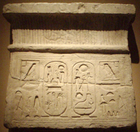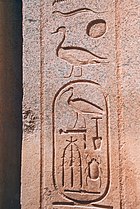Proper name (Pharaoh)
| Proper name in hieroglyphics | |||||||||||
|---|---|---|---|---|---|---|---|---|---|---|---|
S3 Rˁ .... son of Re , .... |
|||||||||||
The proper name (also name at birth ) of an ancient Egyptian king ( Pharaoh ) is the name that he received at birth and that was not only given to him at or with the accession to the throne. The title "Son of Re" ( Sa Ra ) is added to the proper name from the 4th dynasty after the accession to the throne . Another name for this is also Sa-Ra name .
The proper names are not documented in the early dynastic period and in the beginnings of the Old Kingdom . The real names / birth names determined for this period come from later king lists.
Proper name / maiden name
With the birth of a king's son (prince) it was not determined whether he would succeed his father on the throne. So his real name or birth name corresponded to the name of a normal citizen and did not contain a “program”, as expressed by the complete royal statute with all five titles. However, it happened that he received the name of his father or grandfather. The name of a prince was introduced with the words "son of the king, from his body" and not written in a cartouche (also known as a king's ring or name ring). In addition to the proper name, of the king's five titles, only the throne name was enclosed in a cartouche.
The Sa Ra name

Translated, Sa Ra means "son of Re" or "son of the sun god". The Sa-Ra title, also Sa-Ra name, is introduced by the hieroglyphs of a goose and the sun disk in front of the king's proper name (birth name), which is enclosed in a cartouche after the coronation.
Development of the title
The king always points out in temple inscriptions that he is the son of the deity worshiped there: the god or goddess are the father and mother of the king and the making of offerings is the duty of their son. According to the dogma valid in the 4th dynasty , the father of the king is the creator god who fathered the king with his earthly mother. When the sun god of Heliopolis rises to the highest of the gods, this also belongs to the state cult around the king. The sons of Cheops are given names that place them under the protection of the god Re . The kings of the 5th dynasty take on such a name when they ascend the throne, which from the 6th dynasty onwards always expresses a relationship to the sun god.
At first the proper name was written in the cartouche without Sa Ra . Fragments from the mortuary temple of Radjedef so far constitute the first evidence for the "son of Re" name. However, at this point it is not yet a “title” of the king, but an epithet or an epithet. This name is used as an epithet by the kings of the Old Kingdom up to the 6th Dynasty. However, the writing was usually done behind the cartridge.
Pharaoh Unas wrote the title in front of the proper name, but still within the name cartouche. This spelling is often still to be found in the Middle Kingdom . With a few exceptions, the title "Sa Ra" has been in front of the cartouche since King Meriibre (Cheti) , which is attested by a bronze vessel with his name.
Only later did “Son of Re” become a permanent title in the personal name and also an integral part of the great royal statute (a total of five titles) that the king assumed when he was enthroned . The Sa-Ra name is the last name mentioned in the order of the entire royal statute.
particularities
Occasionally, Egyptian rulers changed their proper name when they ascended the throne, or adopted a more significant one. This has been proven for kings of the 5th dynasty who did it for religious reasons, but also for usurpers of the 13th dynasty and for kings in the 20th dynasty . The best-known changes to a proper name, on the other hand, are those of Amenhotep IV in Akhenaten and those of Tutanch aton in Tutanch amun . The throne names remained unchanged in the latter cases.
- In several inscriptions, King Pepi I referred to himself not as the son of Re , but as the son of Atum , the sun god, who was equated by Heliopolis, and the goddess Hathor . He included these names in the proper name cartouche.
- An inscription on a stele text in the temple of Abu Simbel describes Ramses II as the son of Taten and Sekhmet .
- The proper name of a king is not always introduced with Sa Ra. A votive stele in the Metropolitan Museum of Art shows the real name and throne name of Ramses II without the preceding titles "Sa Ra" and "Nesut Biti".
variants
Like the throne names, proper names have also been extended by so-called epithets since the New Kingdom . The most common epithet is mrj Jmen (meri Imen / Amun - "loved by Amun"), which, even if it can often come before the name, is read after the name: Rˁ-msj-sw mrj-Jmn (Ramesisu meri Imen - "Ramses, loved by Amun").
For example, on the University College 410 stele , King Akhenaten is not referred to as the “son of Re”. Here his proper name is preceded by the designation " Lord of the Crowns " ( neb-chau ).
See also
- WP convention for the spelling of the pharaohs' names
- Horus name
- Sideline
- Gold name
- Throne name
- Manetho
- Pharaoh
literature
- Jochem Kahl: "Ra is my Lord". Searching for the Rise of the Sun God at the Dawn of Egyptian History (= Menes. Vol. 1). Harrassowitz, Wiesbaden 2007, ISBN 978-3-447-05540-6 .
- Jürgen von Beckerath : Handbook of the Egyptian king names (= Munich Egyptological studies . Vol. 49). 2nd, improved and expanded edition, von Zabern, Mainz 1999, ISBN 3-8053-2591-6 , pp. 25-26.
- Thomas Schneider : Lexicon of the Pharaohs. The ancient Egyptian kings from the early days to Roman rule. 2nd Edition. Artemis & Winkler, Düsseldorf et al. 1997, ISBN 3-7608-1102-7 .
Individual evidence
- ↑ Jochem Kahl: "Ra is my Lord". 2007, p. 8.
- ↑ a b c Jürgen von Beckerath: Handbook of the Egyptian king names. 1999, p. 26.
- ^ Jürgen von Beckerath: Handbook of the Egyptian king names. 1999, p. 25.
- ^ Jürgen von Beckerath: Handbook of the Egyptian king names. 1999, pp. 25-26.
- ↑ Rolf Felde: Egyptian kings and queens. 2nd edition, R. Felde Eigenverlag, Wiesbaden 2004, p. XII.
- ↑ Fig. 10 in Alfred Grimm , Sylvia Schoske (ed.): The secret of the golden coffin. Akhenaten and the end of the Amarna period (= writings from the Egyptian collection. Vol. 10). State Collection of Egyptian Art Munich, Munich 2001, ISBN 3-87490-722-8 , p. 29.

